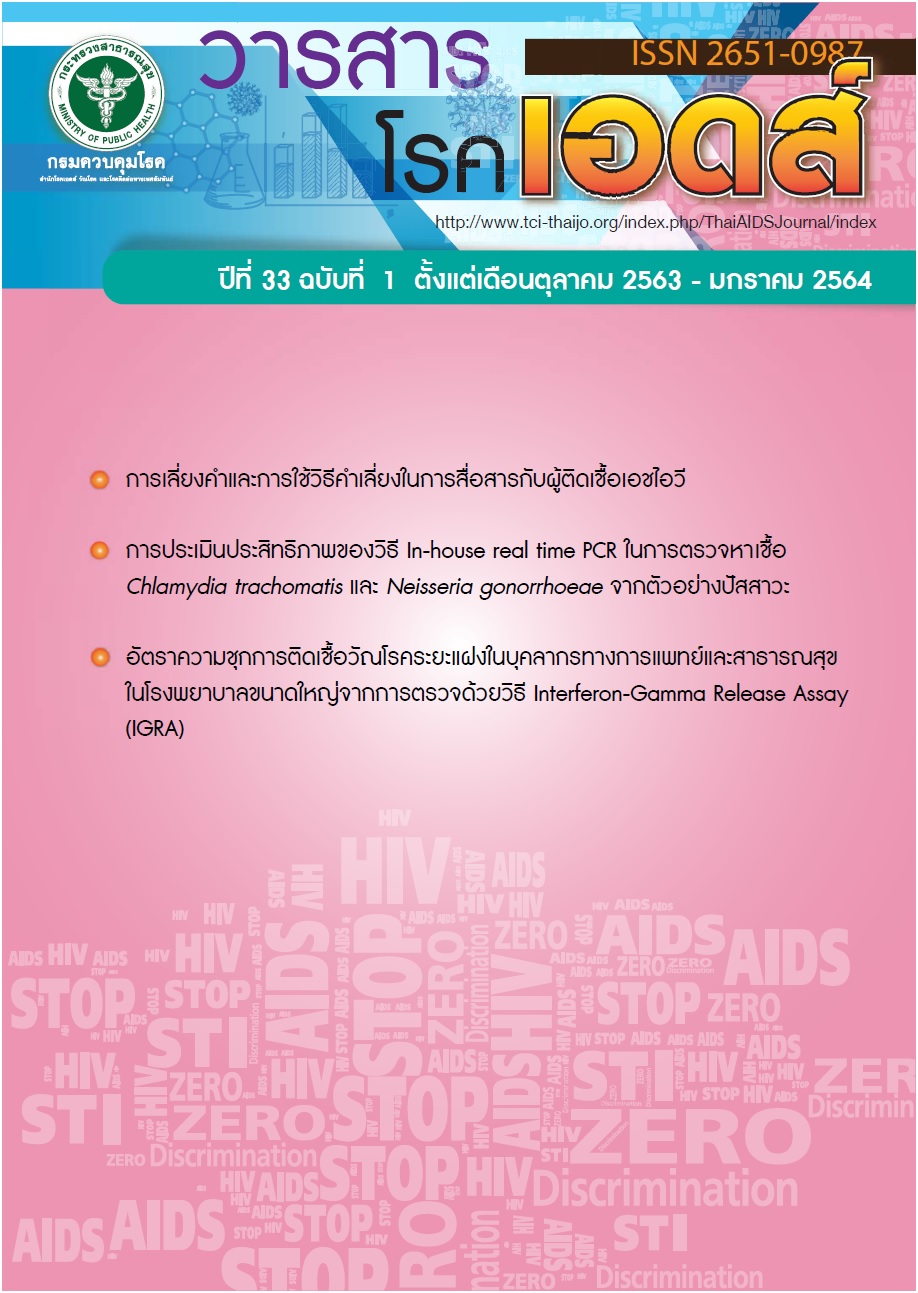Prevalence of Latent TB infection among healthcare workers identified by Interferon-Gamma Release Assay (IGRA) testing in Large Hospital
DOI:
https://doi.org/10.14456/10.14456/taj.2021.3Keywords:
Latent Tuberculosis Infection, Interferon-Gamma Release Assay, Health Care WorkerAbstract
This study was designed as a descriptive cross-sectional study, using 2 serial surveys to determine the prevalence of latent TB infection (LTBI) and related risk factors among health care workers (HCWs) in 24 large hospitals (Regional and Provincial hospitals) countrywide.
In the first survey, 911 HCWs participated in the study and their bloods were tested by Interferon-Gamma Release Assay: IGRA (QuantiFERON-TB Gold Plus). The result revealed that LTBI rate was 26.13% (238/911). The LTBI rate among male HCWs was significantly higher than female (35.24 vs 24.47%) (P<0.05). Infection rates among medical doctors and dentists, laboratory staffs, pharmacists and pharmacological staffs, radiology technicians and supporting administrative staffs were 36.00, 41.17, 42.86, 40.00, and 33.33% respectively. Risk factors that showed to be statistically significant difference in LTBI infection rates indicated by univariate analysis included duration of work which HCWs who worked longer than 2 years had higher rate of LTBI rate (32.16%) as compare to other group (P<0.01). The other significant factor was unit of work which HCWs worked in accident and emergency room (ER) had higher rate of LTBI (41.46%) (P<0.05).
Repeated IGRA test was conducted in the second survey at one year interval after the first survey. Out of 673 HCWs with negative result in the first survey, 517 (76.83%) participated in the survey. The result revealed an incidence of LTBI among HCWs (Converter) which was 6.96%. Nurse and practical nurse had highest risk of recent TB infection rate of 7.26 %. Incidence rates by working units in OPD, ER, and ICU were 13.33, 11.90 and 7.78% respectively.
It is recommended that measures on infection control should be strengthened, while regular health checkup and TB screening among HCWs should be done continuously.
Downloads
References
World Health Organization. Latent tuberculosis infection: updated and consolidated guidelines for programmatic management. Geneva: WHO; 2018.
Division of Tuberculosis, Department of Disease Control, Ministry of Public Health (TH). Guidelines for prevention and control of tuberculosis transmission. 1st edition, Bangkok: Aksorn graphic and design publishing (TH); 2018. (in Thai)
World Health Organization. Global tuberculosis report 2018. Geneva: WHO; 2018: 16-18.
Wanlop Payanan, Nirat Boddee, Niphon Udomrati, Sunan Na Songkhla, Watcharee Saribut. 3rd Survey of Tuberculosis in Thailand 2000-2002. Division of Tuberculosis, Department of Disease Control, Ministry of Public Health (TH). The Agricultural Cooperative Federation of Thailand. Limited. (in Thai)
Division of Tuberculosis, Department of Disease Control, Ministry of Public Health (TH). Tuberculosis Control Guidelines Thailand, 2018. 1st edition, Bangkok: Aksorn graphic and design publishing (TH); 2018. (in Thai)
Hfocus.org. [internet]. Udonthani: Phiwat Thai public health Foundation (TH); 2012. The survey revealed 31.41 % of health workers infected with latent tuberculosis; 2018 [2018 Nov 25]; [about 1p.]. Available from https://www.hfocus.org/content/2018/11/16525.
Centers for Disease Control. TB Elimination Interferon-Gamma Release Assays (IGRAs) – Blood Tests for TB Infection. CDC/November 2011.
Centers for Disease Control and prevention. Guidelines for the investigation of contact of persons with infectious tuberculosis recommendations from the national tuberculosis controllers association and CDC. Mord Mortal Wkly Res 2005; 54: 49-55.
S. K. Sharma, R. Vashishtha, L. S. Chauhan, V. Sreenivas, D. Seth. Comparison of TST and IGRA in Diagnosis of Latent Tuberculosis Infection in a High TB Burden Setting. [internet]. 2017 Jan 6 [cited 2020 Aug. 15]; 10(13): 6-7. Available from https://doi.org/10.1371/ Journal.pone.0169539.
Petchwan Phuengrassamee, Weerasak Chongtowiwatwong. TB in some population groups in Thailand : 62 articles reviewed during 1968 to 1998. Report of Academic Documentation on Tuberculosis Project. Ph.D. Project Kanchanaphisek Research Fund (TRF); 1999.
P. Pongwittayapanu, T. Anothaisintawee, K. Malathum, C. Wongrathanandha. Incidence of Newly Diagnosed Tuberculosis among Healthcare Workers in a Teaching Hospital Thailand, Annals of Global Health. 2018; 84(3), 342–347.
AN. Do, K. Limpakarnjarat, W. Uthaivoravit, P.L. Zuber, S. Korattana, N. Binkin. Increased risk of Mycobacteriumtuberculosis infection related to the occupational exposures of health care workers in Chiang Rai, Thailand. The international journal of tuberculosis and lung disease : the official journal of the International Union against Tuberculosis and Lung Disease. 1999; 3 (5) : 377-81.
D. Nonghanphithak, W. Reechaipichitkul, T. Chaiyasung, K. Faksri. Risk Factors for Latent Tuberculosis Infection among Health-care workers in North-Eastern Thailand, South-East Asian J Trop Med Public Health. 2016; 47 (6) :1198 – 1208.
H. Yanai , K. Limpakarnjanarat, W. Uthaivoravit, Mastro TD, T. Mori, JW. Tappero Risk of mycobacterium tuberculosis infection and disease among health care workers, Chiang Rai, Thailand. Int J Tuberc Lung Dis 2003; 7: 36-45.
Pattama Suttha, Nathu Sanguanwong, Pranormnopakhun, Patchara Tanteeraphat. Changes in dermal tuberculin test results in personnel operating at Bamrasnaradura Institute. Journal of Disease Control, 2012; 38 (3): 228 - 235.



